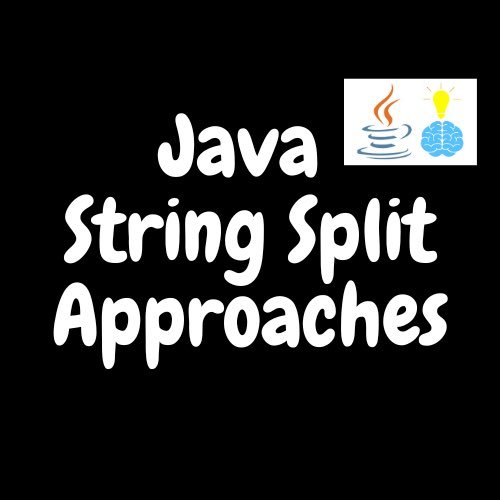In Java programming, the ability to split strings is a common and essential task. The “java string split” operation allows you to divide a string into multiple substrings based on a specified delimiter. This operation is useful for tasks such as parsing data, extracting relevant information, and manipulating strings. In this article, we will delve into the different ways you can perform string splitting in Java, including splitting by spaces. We will provide sample Java code and corresponding output to illustrate each approach, allowing you to grasp the concepts and apply them in your own projects.
Different Ways to perform Java String Split

Using the split() Method
The split() method in the String class is the most straightforward way to split a string in Java. It takes a regular expression as the delimiter and returns an array of substrings. To split a string by a space, you can pass a space character or “\s+” as the delimiter. Here’s an example:
String sentence = "Hello Java String Split";
String[] words = sentence.split(" ");
words = ["Hello", "Java", "String", "Split"]
Splitting with Limit:
The split() method also supports an optional “limit” parameter that determines the maximum number of substrings to be created. This parameter can be useful when you only want to split the string into a certain number of parts. Here’s an example:
String sentence = "Hello Java String Split";
String[] words = sentence.split(" ", 2);
words = ["Hello", "Java String Split"]
Splitting with Regular Expressions
Java’s split() method supports regular expressions as delimiters, allowing for more advanced string splitting. You can leverage regular expressions to split strings based on complex patterns or multiple delimiters. Here’s an example of splitting a string using a regular expression:
String sentence = "Hello,Java;String|Split";
String[] words = sentence.split("[,;|]");
words = ["Hello", "Java", "String", "Split"]
Using StringTokenizer
Another way to split strings in Java is by using the StringTokenizer class. This class provides methods to break a string into tokens based on a specified delimiter. Here’s an example:
String sentence = "Hello Java String Split";
StringTokenizer tokenizer = new StringTokenizer(sentence);
while (tokenizer.hasMoreTokens()) {
String word = tokenizer.nextToken();
System.out.println(word);
}
Hello
Java
String
Split
Splitting with Java 8 Streams
Java 8 introduced the Stream API, which provides a powerful way to process collections of elements. We can leverage streams to split a string into substrings and collect them into a list or any other desired data structure. Here’s an example:
String sentence = "Hello Java String Split";
List<String> words = Arrays.stream(sentence.split(" "))
.collect(Collectors.toList());
words = ["Hello", "Java", "String", "Split"]
In this approach, we use the split() method to divide the string into an array of substrings. We then convert the array into a stream using Arrays.stream() and utilize the collect() method along with Collectors.toList() to gather the substrings into a list.
Splitting with Java 9’s String::splitAsStream
In Java 9, the splitAsStream method was introduced in the String class. This method returns a stream of substrings based on a specified delimiter. Here’s an example:
String sentence = "Hello Java String Split";
List<String> words = sentence.splitAsStream(" ")
.collect(Collectors.toList());
words = ["Hello", "Java", "String", "Split"]
The splitAsStream method allows us to directly obtain a stream of substrings without the need to convert an array. We can then use stream operations or collect the substrings into a desired data structure.
Splitting into Lines with Java 11’s String::lines
In Java 11, the lines method was introduced in the String class. This method splits the string into lines based on the line terminators (‘\n’ or ‘\r\n’) and returns a stream of lines. Here’s an example:
String text = "Hello\nJava\nString\nSplit";
List<String> lines = text.lines()
.collect(Collectors.toList());
lines = ["Hello", "Java", "String", "Split"]
The lines method simplifies splitting a string into lines, especially when dealing with multiline text. It provides a convenient way to process each line individually.
Splitting with Apache Commons Lang
If you have Apache Commons Lang library included in your project dependencies, you can utilize the StringUtils class to split strings. This library provides a convenient split() method that simplifies string splitting operations. Here’s an example:
import org.apache.commons.lang3.StringUtils;
String sentence = "Hello Java String Split";
String[] words = StringUtils.split(sentence, " ");
words = ["Hello", "Java", "String", "Split"]
By using Apache Commons Lang, you can simplify the string splitting process and take advantage of additional utility methods provided by the library.
Conclusion: Java String String Approaches
In this article, we explored various approaches to splitting strings in Java, including different methods and techniques available. We discussed the traditional split() method, StringTokenizer, splitting with regular expressions, leveraging Java 8 streams, utilizing Java 9, Java 11 features and Apache Commons Lang Library.
By understanding and applying these different approaches, you now have a range of options to choose from based on your specific requirements and preferences. Whether you need to split strings by a simple delimiter, handle more complex patterns, or leverage advanced features, there is a suitable method available for you.
